- Outras empresas da Fluke:
- Fluke
- Fluke Biomedical
- Fluke Networks
- Fluke Process Instruments
Mars Science Laboratory
Mars Science Laboratory - measurement and calibration on Mars
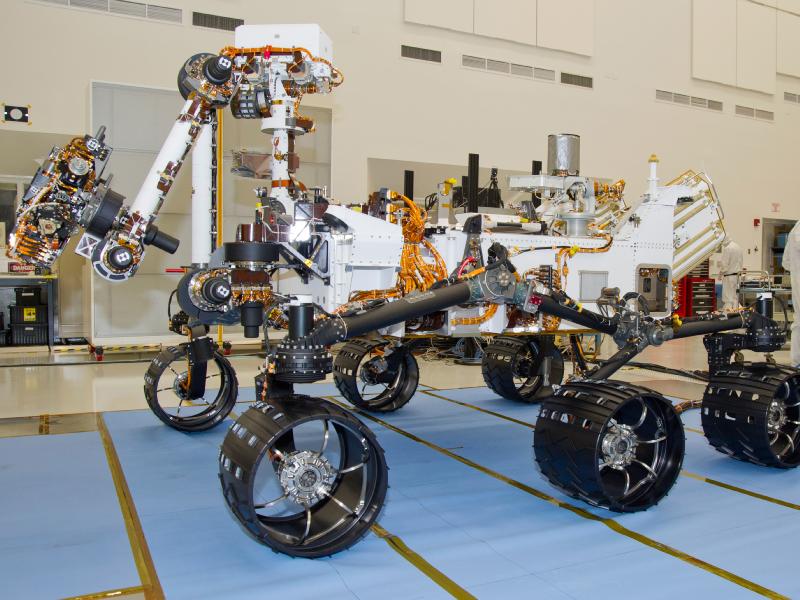 |
You can bet there is a lot of test and measurement equipment onboard Curiosity. As a test and measurement professional, I’d like to tell you about some of the things I find especially interesting. |
Mars Science Laboratory - measurement and calibration on Mars
 |
You can bet there is a lot of test and measurement equipment onboard Curiosity. As a test and measurement professional, I’d like to tell you about some of the things I find especially interesting. Curiosity landed on Mars August 5, 2012. Literally a roving science laboratory, Curiosity is tightly packed with precision measurement equipment that would normally fill a much larger laboratory. Ten powerful scientific instruments for investigations submitted by scientists from around the world fit into an 899 kilogram rover that is just 3.0 meters long 2.8 meters wide, and 2.1 meters tall (not including the 2.1 meter arm). |
|
Profile view of the Mars Science Laboratory
Courtesy NASA/JPL-Caltech.
|
With a total price tag of $2.5 billion and the inherent challenges of shooting a laboratory through space at 13,200 miles per hour toward a rock 154 million miles away, you might well wonder “how do they stay calibrated?”
In fact, calibration is a high priority on Curiosity. On the second day (a Martian day is about 40 minutes longer than an Earth day), Curiosity needs to get the high-gain antenna for communications pointed towards Earth. As part of calibrating its positioning accuracy, Curiosity raises its mast holding several cameras including the Navigation Camera (Navcam). Navcam images the sky to determine the location of the Sun and calculate the angle towards Earth. Images taken by the other cameras on the mast showing calibration targets and the terrain around the rover reach Earth during the first few days after landing. In fact, during the first several weeks on Mars, Curiosity will be put through a commissioning phase with about a month of characterization activities to learn how all the subsystems and instruments are functioning after landing.
10 amazing measurement instruments on the Mars Science Laboratory
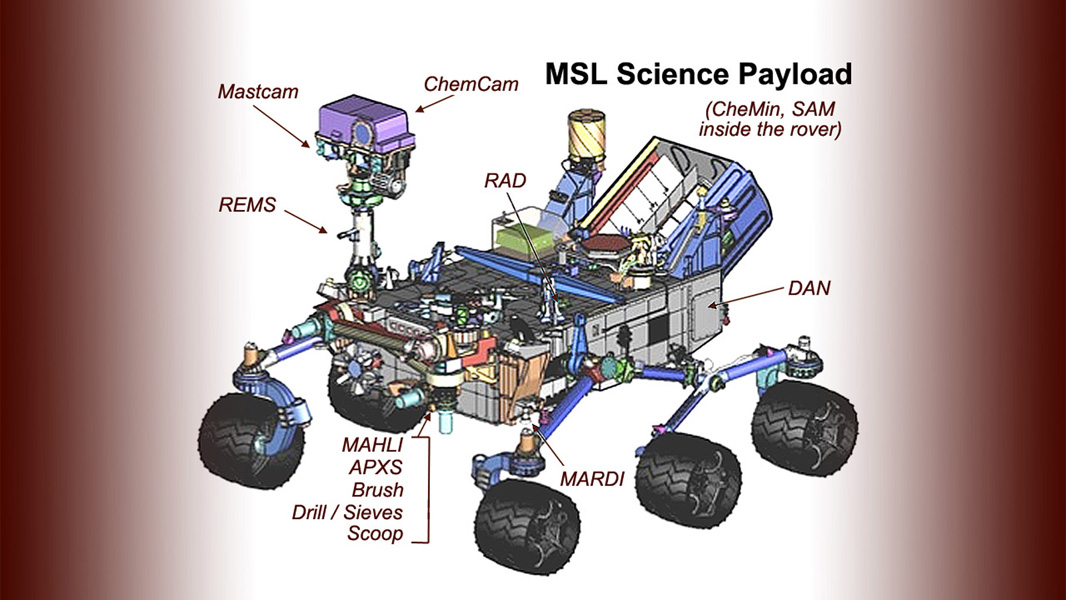
#1 Mastcam - Mast Camera
#2 ChemCam - Chemistry and Camera
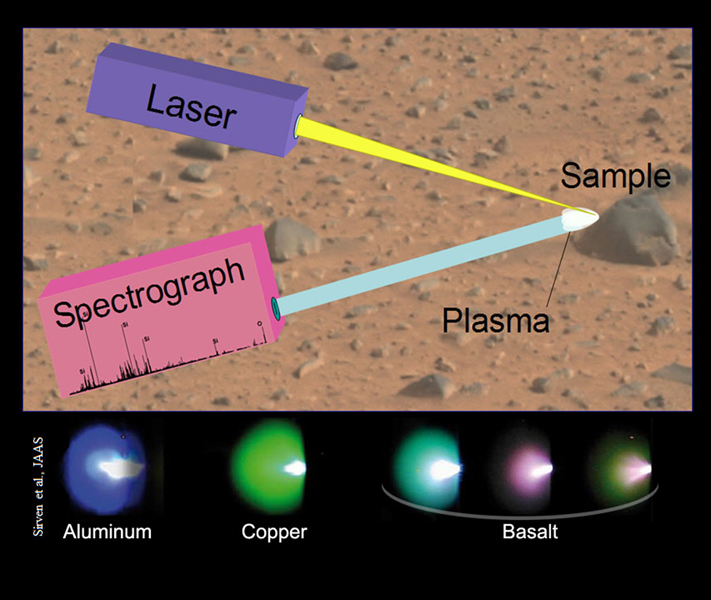 |
ChemCam is a rock-zapping laser, telescope, and spectrometer. It produces more than a million watts of power focused for five one-billionths of a second to hit targets up to seven meters away. The result is a glowing ionized gas which it observes with the telescope. The spectrometer analyzes the spectrum of light to identify the chemical elements of the target. The technology is also used in other extreme conditions such as nuclear reactors and the sea floor. |
|
Schematic of laser-induced breakdown spectroscopy technique used by ChemCam on Mars. Courtesy NASA/JPL-Caltech.
|
#3 REMS – Rover Environmental Monitoring Station
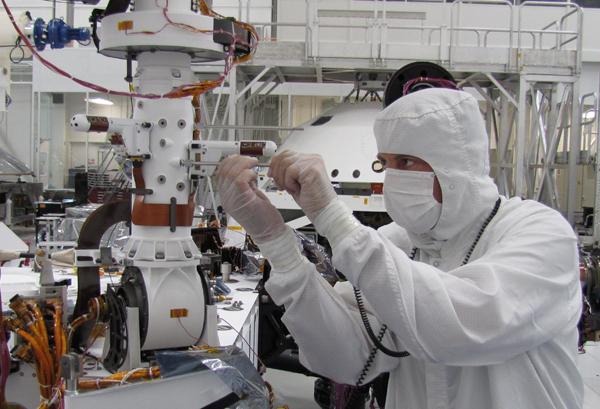 |
REMS records environmental information for five minutes out of every hour for the duration of the 98-week mission. This will help us understand seasonal changes in Martian weather. It records wind speed, wind direction, air pressure, relative humidity, air temperature, ground temperature, and ultraviolet radiation. Information about wind, temperatures, and humidity comes from electronic sensors on two finger-like booms. |
|
A specialist installs REMS on to the mast
of the Mars Rover Curiosity. Courtesy NASA/JPL-Caltech.
|
The booms extend from the main vertical mast holding the ChemCam laser and the Mastcam. Each boom holds an air temperature sensor and three sensors for detecting air movement in three dimensions. The first boom also has an infrared sensor for measuring ground temperature. The second boom contains the humidity sensor which is inside a downward-tilted protective cylinder. The pressure sensor sits inside the rover body, connected to the external atmosphere by a tube to a small, dust-shielded opening on the deck.
#4 SAM – Sample Analysis at Mars
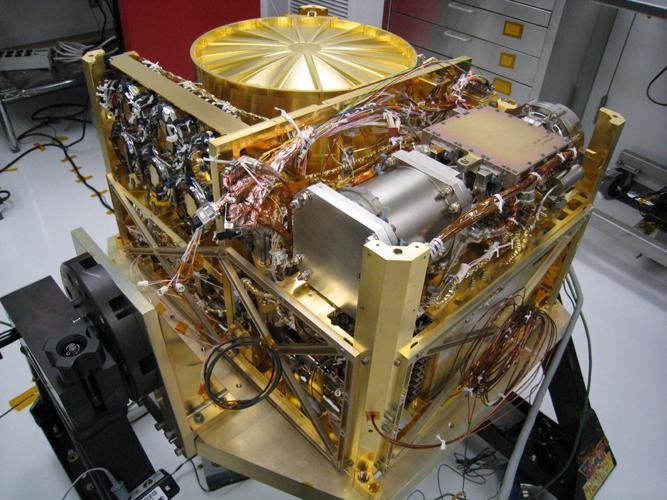 |
SAM will study the chemistry relevant to life. It has an amazing amount of organic chemistry capability packed into a box the size of a microwave. There is a mass spectrometer, a tunable laser spectrometer, and a gas chromatograph. That’s a laboratory in a box. It will analyze gases from the atmosphere and gases from rock samples. It’s capable of detecting even faint traces of a wide variety of carbon based compounds. The sample manipulation system maneuvers 74 sample cups, each about one-sixth of a teaspoon in volume. Six of the cups hold solids. SAM also carries samples of gases for calibration. |
| Sample Analysis at Mars (SAM) Instrument. Courtesy NASA/JPL-Caltech. |
#5 RAD – Radiation Assessment Detector
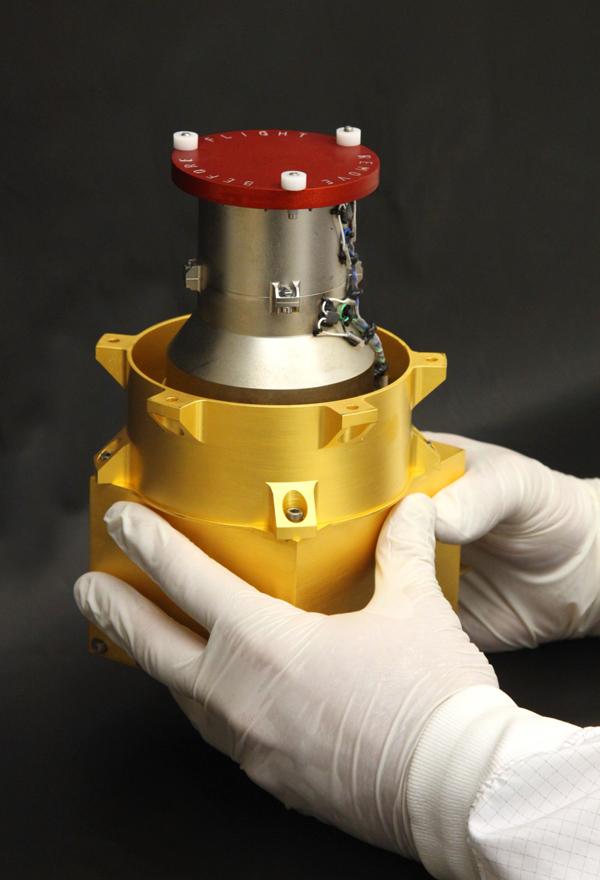 |
RAD monitors high-energy atomic and sub atomic particles coming from the sun, from distant supernovae and other sources to determine whether conditions are favorable to life and preserving evidence of life. Naturally occurring radiation could be harmful to microbes near the surface of Mars or to future astronauts. The concerns arise because Mars lacks a protective magnetic field and only has one percent of the atmosphere Earth has. To find high enough radiation levels to calibrate RAD, the instrument team needed to put it inside major particle-accelerator research facilities in the United States, Europe, Japan and South Africa. |
| RAD will monitor high-energy atomic and subatomic particles. Courtesy NASA/JPL-Caltech. |
#6 DAN – Dynamic Albedo of Neutrons
10 times per second, DAN shoots neutrons into the ground. The blasts are 10 million neutrons each in 1 microsecond pulses. Dan measures how the neutrons are scattered in order to detect Hydrogen which is evidence of water bound into shallow (50 cm) underground minerals in Curiosity’s path.
#7 APXS – Alpha Particle X-Ray Spectrometer
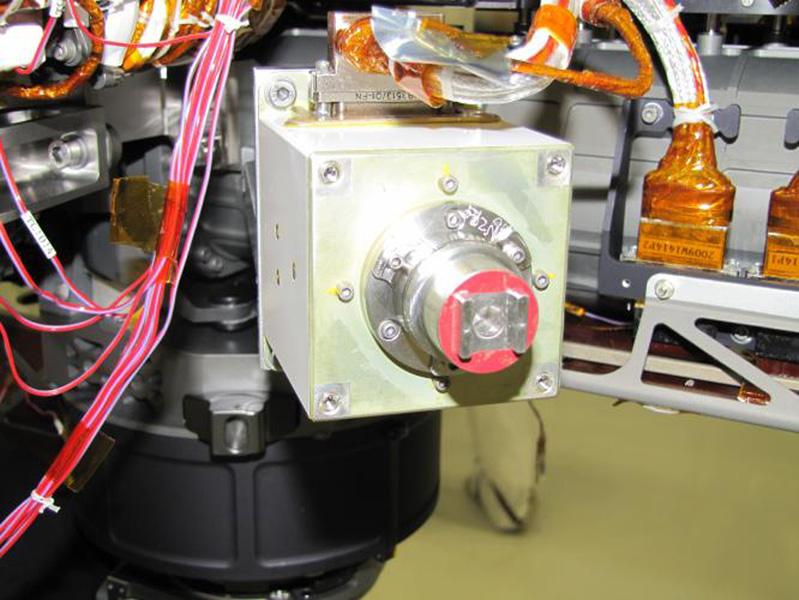 |
APXS identifies chemical elements in rocks and soils placed on the rover’s observation tray and soil freshly exposed by the rover’s wheels. It emits radiation at samples and an X-ray detector reads the results. An onboard basaltic rock slab, surrounded by nickel plate will be used to periodically calibrate and check the performance of the instrument. |
| Sensor head on the Alpha Particle X-ray Spectrometer which is about 7.8 centimeters tall. Courtesy NASA/JPL-Caltech. |
#8 MAHLI – Mars Hand Lens Imager
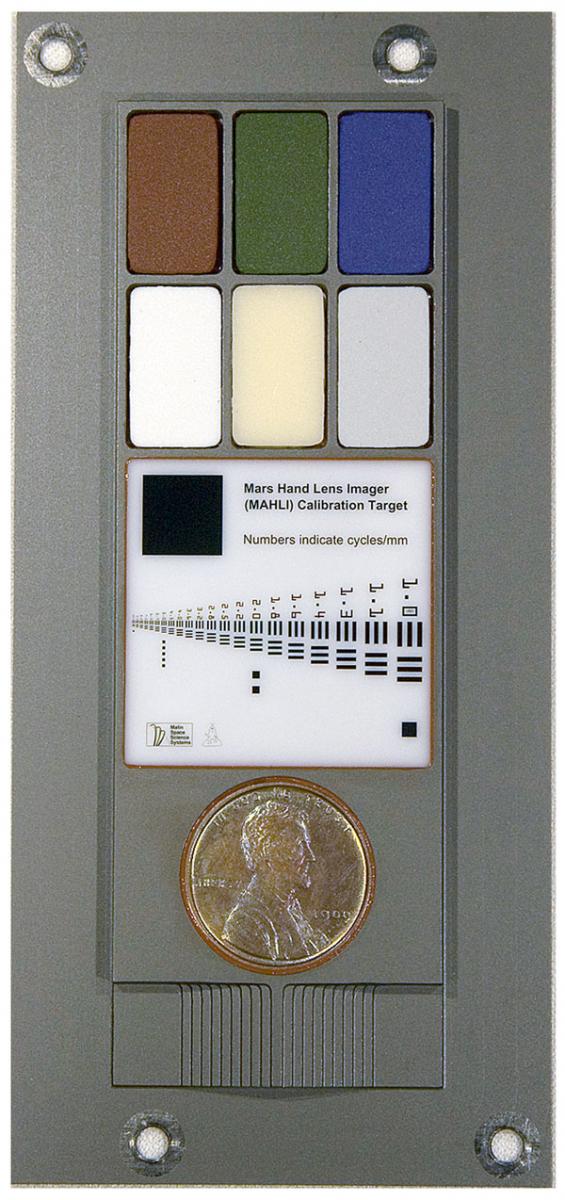 |
Similar to the hand lens magnifying tool carried by field geologists, MAHLI is used for close up views of rocks and soils. It’s capable of producing full color images. Curiosity carries a vertically mounted calibration target for MAHLI for checking color, white balance, resolution, focus and the ultraviolet illumination.
The MAHLI calibration target includes color chips, a metric standardized bar graphic, a penny, and a stair step pattern for depth calibration. Just above the left edge of the penny, is a tiny cartoon figure called “Joe the Martian”. The penny is from 1909, the first year Lincoln pennies were minted.
|
| MAHLI calibration target.Courtesy NASA/JPL-Caltech. |
#9 CheMin – Chemistry and Mineralogy
# 10 MARDI – Mars Descent Imager
If you enjoyed this blog post, you might also like this one: A new look at a triumph of engineering and ingenuity from 1968.
- Anmelden oder Registrieren um Kommentare zu schreiben
- Printer-friendly version »
- Início
- Produtos
- Novos Produtos
- Calibração elétrica
- Calibração de RF
- Equipamento de aquisição de dados e de teste
- Calibração de temperatura
- Calibração de umidade
- Calibração de pressão
- Medidores de pistão
- Controlador/Calibradores
- Monitores de pressão
- Balanças de peso morto
- Calibradores manuais e monitores
- Handheld Pressure Calibrators
- Calibração de dados de aéreos
- Monitores ambientais
- Acessórios de calibração de pressão
- Sistemas personalizados de calibração de pressão
- Software de calibração de pressão
- Calibração de fluxo
- Ferramentas de Calibração de processo
- Software de calibração
- Serviço e suporte
- Todos os instrumentos de calibração
- Onde Comprar
- Notícias
- Treinamento e eventos
- Literatura e educação
- Serviço e Suporte
- Service Request (RMA)
- Planos de Serviço
- Suporte técnico
- Base de Conhecimento
- Acreditações
- Centros de assistência autorizados
- Calibration Certificates
- Community Forum
- My MET/SUPPORT
- Manuais de produto (Guias de usuário)
- Folhas de Dados de Segurança (SDS)
- Safety, Service, and Product Notices
- Downloads de software
- Sobre Nós


